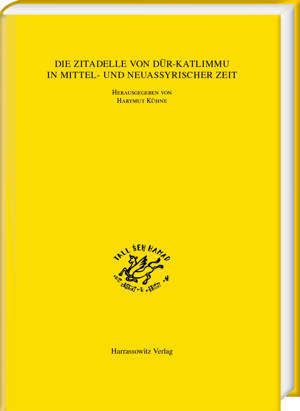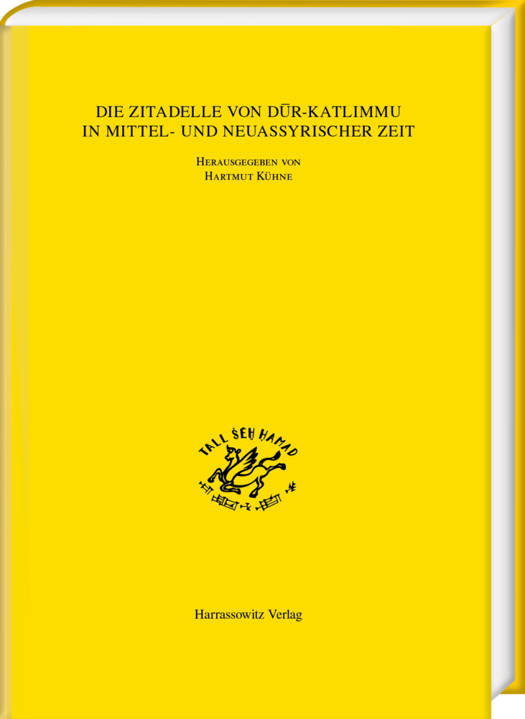
- Retrait gratuit dans votre magasin Club
- 7.000.000 titres dans notre catalogue
- Payer en toute sécurité
- Toujours un magasin près de chez vous
- Retrait gratuit dans votre magasin Club
- 7.000.0000 titres dans notre catalogue
- Payer en toute sécurité
- Toujours un magasin près de chez vous
Die Zitadelle Von Dur-Katlimmu in Mittel- Und Neuassyrischer Zeit
604,45 €
+ 1208 points
Description
English summary: Following BATSH 2 (2005) on the Post-Assyrian to Roman period, the three-part volume BATSH 12 on the Middle and Neo-Assyrian period (c. 1300-550 BC), also edited by Hartmut Kuhne, concludes the publication of the excavation at the citadel mound of Tall Seh Hamad between 1978 and 1988. Part 1 (text) comprises 17 chapters. A thorough documentation of the topography of Tall Seh ?amad at the dawn of the excavation in 1978 is followed in four chapters (2-5) by description and interpretation of the stratigraphy, architecture, cuneiform archive, and graves of the Middle Assyrian levels. Chapters 14 and 15 cover the Neo-Assyrian evidence in a similar way. Both can be checked against the field record summarized in chapter 18 (part 2) and ultimately against the field diaries published online. Selected Middle Assyrian objects groups are analyzed in chapters 6 to 10 (clay sealing devices, scarab impressions, early iron, glass, and ceramics). Aspects of Middle Assyrian administration and the etymology of Duara are treated in chapters 11 and 13. Chapter 16 evaluates the fragments of a Neo-Assyrian sculptured orthostat. The urban and socio-economic-environmental development and the historical role and significance of Dur-Katlimmu in both periods are debated in chapters 12 and 17 respectively. Besides chapter 18 part 2 covers the catalogues of the scarab impressions (19), the grave goods (21) and the remaining objects of the Middle (20) and Neo-Assyrian (22) periods. Each chapter is preceded by English abstracts/summaries on which the Arabic part is based. In addition, the publication is supplemented by a cassette with 57 colour plates and folding plans in part 3. In collaboration with: H. Kuhne, P. Pfalzner, J. Rohde, S. Kulemann-Ossen/G. Preuss, H. Dohmann, S. Seidlmayer, K. Tantrakarn/T. Kikugawa/Y. Abe/I. Nakai, E. Cancik-Kirschbaum, C. Hess, J. Bussiliat/K. Gnybek/A. Kaeselitz/H. Kuhne/J. Rohde. German description: Nach BATSH 2 (2005) zur nachassyrischen bis romischen Zeit beschliesst der ebenfalls von Hartmut Kuhne herausgegebene dreiteilige Band BATSH 12 zur mittel- und neuassyrischen Zeit (ca. 1300-550 v.Chr.) die Publikation der Grabung am Zitadellenhugel des Tall Seh Hamad zwischen 1978 und 1988. Teil 1 (Text) umfasst 17 Kapitel. Auf eine ausfuhrliche Dokumentation der Topographie des Tall seh Hamad zu Beginn der Ausgrabung 1978 folgen in vier Kapiteln (2-5) Beschreibung und Interpretation von Stratigraphie, Architektur, Keilschriftarchiv und Grabern des mittelassyrischen Horizontes. Die Kapitel 14 und 15 behandeln die Stratigraphie und Architektur der neuassyrischen Schichten. Beide konnen mit dem in Kapitel 18 (Teil 2) zusammengefassten Felddatensatz und letztlich mit den online publizierten Feldtagebuchern abgeglichen werden. Ausgewahlte Objektgruppen aus dem mittelassyrischen Kontext werden in den Kapiteln 6 bis 10 analysiert (Tonsicherungen, Skarabaenabdrucke, fruhes Eisen, Glas und Keramik). In den Kapiteln 11 und 13 werden Aspekte der mittelassyrischen Verwaltung sowie die Etymologie von Duara besprochen. In Kapitel 16 werden die neuassyrischen Orthostatenfragmente kulturhistorisch ausgewertet. Eine Bewertung der soziookonomisch-okologischen Entwicklung und der historischen Rolle und Bedeutung von Dur-Katlimmu in mittel- und neuassyrischer Zeit erfolgt in den Kapitel 12 und 17. Teil 2 umfasst ausser Kapitel 18 die Kataloge zu den Skarabaenabdrucken (19), Grabbeigaben (21) und zu den sonstigen Objekten der mittel- (20) und neuassyrischen (22) Periode. Jedem Kapitel vorangestellt sind englische Abstracts/Zusammenfassungen, auf denen wiederum der arabischsprachige Teil basiert. Teil 3 besteht aus einer Kassette mit 57 Farbtafeln und Faltplanen. Unter Mitarbeit von: H. Kuhne, P. Pfalzner, J. Rohde, S. Kulemann-Ossen/G. Preuss, H. Dohmann, S. Seidlmayer, K. Tantrakarn/T. Kikugawa/Y. Abe/I. Nakai, E. Cancik-Kirschbaum, C. Hess, J. Bussiliat/K. Gnybek/A. Kaeselitz/H. Kuhne/J. Rohde.
Spécifications
Parties prenantes
- Editeur:
Contenu
- Nombre de pages :
- 758
- Langue:
- Anglais, Allemand
- Collection :
- Tome:
- n° 12
Caractéristiques
- EAN:
- 9783447061681
- Date de parution :
- 11-11-20
- Format:
- Livre relié
- Format numérique:
- Genaaid
- Dimensions :
- 239 mm x 343 mm
- Poids :
- 566 g

Les avis
Nous publions uniquement les avis qui respectent les conditions requises. Consultez nos conditions pour les avis.





